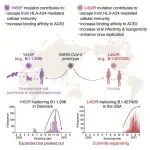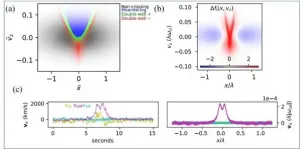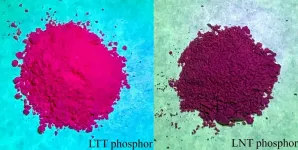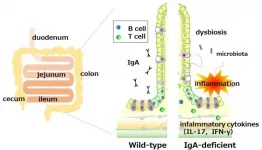Spinal fluid biomarkers detect neurodegeneration, Alzheimer's disease in living patients
Alzheimer's disease and other forms of neurodegeneration can be identified using a combination of biomarkers in cerebrospinal fluid of living patients, Penn researchers find
2021-07-20
(Press-News.org) PHILADELPHIA--Alzheimer's disease and related diseases can still only be confirmed in deceased patients' brains via autopsy. Even so, the development of biomarkers can give patients and their families answers during life: Alzheimer's disease can be accurately detected via peptides and proteins in a patient's cerebrospinal fluids (CSF), which can be collected through a lumbar puncture and tested while the patient is alive. In 2018, a new framework suggested combining three Alzheimer's disease biomarkers in CSF - pathologic amyloid plaques (A), tangles (T), and neurodegeneration (N), collectively called ATN. According to recent research from the Perelman School of Medicine at the University of Pennsylvania, the ATN framework can be extended to detect another neurodegenerative condition: frontotemporal degeneration.
Patients with frontotemporal degeneration can experience a range of symptoms, including behavioral changes, executive dysfunction, and language impairments. Distinguishing frontotemporal degeneration from Alzheimer's disease can be a challenge for clinicians: the symptoms of frontotemporal degeneration can sometimes overlap with Alzheimer's disease, and a subset of patients can even have both pathologies. Biomarkers can fill the gap by providing evidence of whether Alzheimer's pathology underlies a patient's symptoms.
"CSF biomarkers work similarly to a pregnancy test, offering a simple positive or negative result when enough of a substance is detected. But like a pregnancy test, biomarkers for Alzheimer's disease can provide false negatives or positives," said lead investigator Katheryn A.Q. Cousins, PhD, a research associate in the Frontotemporal Degeneration Center in the Department of Neurology at Penn Medicine. "Alzheimer's is a diverse disease, and it is common for other conditions to also be present in the brain. The ATN framework may provide a more complete look at a person's diagnosis and give us a much richer understanding of not only Alzheimer's disease, but other co-occurring neurodegenerative conditions. However, to accomplish this, additional biomarkers that can detect other neurodegenerative conditions are critically needed."
The findings, published in Alzheimer's and Dementia: The Journal of the Alzheimer's Association, show that ATN incorporating neurofilament light chain (NfL) may provide a more accurate and precise diagnosis for patients with frontotemporal degeneration. NfL is a protein abundant in the brain, whose levels increase as degeneration progresses. Cousins' work shows that CSF NfL may be a more accurate marker of neurodegeneration for patients with frontotemporal degeneration, including for Alzheimer's disease.
"While the ATN framework is very exciting and offers much opportunity for patients with Alzheimer's disease, these biomarkers don't capture every case of the disease. We want to be able to detect and treat every patient with neurodegenerative disease as early as possible, and more research is needed to fully understand how biofluids track with the disease process," said Cousins. "I am eager to conduct additional research into which patients might be missed by these markers, what they have in common, and what causes the pathological and clinical differences in the disease."
INFORMATION:
This study was funded by the Swedish Research Council (2018-02532); the European Research Council, (681712); Swedish State Support for Clinical Research (ALFGBG-720931); the Alzheimer Drug Discovery Foundation (201809-2016862); the Swedish Alzheimer Foundation, (AF-742881); European Union Joint Program for Neurodegenerative Disorders (JPND2019-466-236); and the Alzheimer's Association Research Fellowship (AARF-16-44368).
Penn Medicine is one of the world's leading academic medical centers, dedicated to the related missions of medical education, biomedical research, and excellence in patient care. Penn Medicine consists of the Raymond and Ruth Perelman School of Medicine at the University of Pennsylvania (founded in 1765 as the nation's first medical school) and the University of Pennsylvania Health System, which together form a $8.9 billion enterprise.
The Perelman School of Medicine has been ranked among the top medical schools in the United States for more than 20 years, according to U.S. News & World Report's survey of research-oriented medical schools. The School is consistently among the nation's top recipients of funding from the National Institutes of Health, with $496 million awarded in the 2020 fiscal year.
The University of Pennsylvania Health System's patient care facilities include: the Hospital of the University of Pennsylvania and Penn Presbyterian Medical Center--which are recognized as one of the nation's top "Honor Roll" hospitals by U.S. News & World Report--Chester County Hospital; Lancaster General Health; Penn Medicine Princeton Health; and Pennsylvania Hospital, the nation's first hospital, founded in 1751. Additional facilities and enterprises include Good Shepherd Penn Partners, Penn Medicine at Home, Lancaster Behavioral Health Hospital, and Princeton House Behavioral Health, among others.
Penn Medicine is powered by a talented and dedicated workforce of more than 44,000 people. The organization also has alliances with top community health systems across both Southeastern Pennsylvania and Southern New Jersey, creating more options for patients no matter where they live.
Penn Medicine is committed to improving lives and health through a variety of community-based programs and activities. In fiscal year 2020, Penn Medicine provided more than $563 million to benefit our community.
ELSE PRESS RELEASES FROM THIS DATE:
2021-07-20
An international team of researchers led by Kumamoto and Tokyo Universities (Japan) have shown that the L452R mutation of the SARS-CoV-2 spike protein, which is common to two mutant strains (Epsilon and Delta), is involved in cellular immunity evasion via the human leukocyte antigen (HLA) A24, and enhances viral infectivity. HLA-A24 is one of the most prominent HLA-class I alleles, especially in East/Southeast Asian populations, which might make them particularly vulnerable to coronavirus variants with this mutation.
The ongoing novel coronavirus (SARS-CoV-2 or COVID-19) pandemic has, as of June 2021, infected over 150 million and killed over 3.5 million people worldwide. Vaccination drives ...
2021-07-20
A Korean research team has identified the origin of bifurcated current sheets, considered one of the most unsolved mysteries in the Earth's magnetosphere and in magnetized plasma physics.
A POSTECH joint research team led by Professor Gunsu S. Yun of the Department of Physics and Division of Advanced Nuclear Engineering and Dr. Young Dae Yoon from the Pohang Accelerator Laboratory has theoretically established the process of collisionless equilibration of disequilibrated plasma current sheets. In addition, by comparing this with particle simulations and satellite data from NASA, the origin of the bifurcated ...
2021-07-20
Overview:
Professor Hiromi Nakano of Toyohashi University of Technology used a material with a unique periodical structure (smart material: Li-M-Ti-O [M = Nb or Ta]) as a host material to synthesize new Mn4+-activated phosphors that exhibit red light emissions at 685 nm when excited at 493 nm. Because the valence of the Mn ions in the material changes from Mn4+ to Mn3+ according to the sintering temperature, composition, and crystal structure, there is a difference in the photoluminescence intensity of the phosphors. XRD, TEM, and XANES were used to clarify the relationship between the photoluminescence intensity and the sintering temperature, ...
2021-07-20
Chinese researchers along with international colleagues recently reported a 6,700-year-long, precisely dated and well-calibrated tree-ring stable isotope chronology from the Northeastern Tibetan Plateau. It reveals full-frequency precipitation variability in the Asian Summer Monsoon (ASM) from interannual to multimillennial timescales with a long-term decreasing trend and several abrupt climate change events.
The international research team comprised 20 scientists from research groups based in China, Norway, Germany, United Kingdom, USA, Sweden, Canada, and Switzerland ...
2021-07-20
Tokyo, Japan - While researchers have known for years that immunoglobulin A (IgA) is important for gut health, it has remained unclear exactly what role it plays in preventing infection and disease. But now, researchers from Japan have found that eliminating IgA disrupts the balance of the intestinal ecosystem, making it susceptible to disease.
In a study published online in May in Gut, researchers from Tokyo Medical and Dental University (TMDU) have revealed that IgA deficiency results in substantial inflammation of the ileum, a specific part of the small intestine.
IgA is present in large quantities in the small intestine, where it helps protect the body against microorganisms that could potentially cross the lining of the gut to cause ...
2021-07-20
A new study by a team of researchers has found that the consolidation of traditional smallholder farms in China has a devastating effect on the biodiversity of wild pollinators in the area.
Pollinators play an essential role when it comes to supporting global food production.
However, wild pollinators are on the decline for several reasons, including the loss of floral resources and nesting sites. This loss of biodiversity could have far-reaching consequences for global food production in future.
"Biodiversity is essential for all life, with pollinators being one of the most important groups," says Dr Yi Zou from Xi'an Jiaotong-Liverpool ...
2021-07-20
CORVALLIS, Ore. - A 17-year study in Oregon, Washington and California found that removal of invasive barred owls arrested the population decline of the northern spotted owl, a native species threatened by invading barred owls and the loss of old-forest habitats.
The conservation and management of northern spotted owls became one of the largest and most visible wildlife conservation issues in United States history after the U.S. Fish and Wildlife Service listed the spotted owl as threatened under the Endangered Species Act in 1990 because of rapid declines in the owl's old-forest habitats. Four years later, the Northwest Forest Plan was adopted and reduced the rate of logging of old-growth forests on federal lands.
Despite more ...
2021-07-20
Tsukuba, Japan - Scientists from the department of Anatomy and Embryology at the Faculty of Medicine of the University of Tsukuba created a computer model to simulate the development of complex structures based on the Delta-Notch signaling pathway. This work may lead to a more comprehensive picture of the process that results in the formation of organs and other physiological systems.
The development of a tiny embryo consisting of undifferentiated cells into a healthy fetus with spatially defined organs depends on the complex interplay between genetic instructions and signaling molecules. For example, "Notch" genes are ...
2021-07-20
Berkeley -- More than 700 imaging satellites are orbiting the earth, and every day they beam vast oceans of information -- including data that reflects climate change, health and poverty -- to databases on the ground. There's just one problem: While the geospatial data could help researchers and policymakers address critical challenges, only those with considerable wealth and expertise can access it.
Now, a team based at the University of California, Berkeley, has devised a machine learning system to tap the problem-solving potential of satellite imaging, using low-cost, ...
2021-07-20
CATONSVILLE, MD, July 20, 2021 - Uber and Lyft are popular on-demand ways to travel, but does that mean trains and buses are a thing of the past? Travelers prefer different modes of transportation at different times. So how can all these modes co-exist and do so successfully? New research in the INFORMS Journal Transportation Science has created a model and an algorithm to redistribute transit resources based on commuter preferences resulting in millions in savings.
"Based on case study experiments in New York City, our optimized transit schedules consistently lead to 0.4%-3% system-wide cost reduction. This amounts to rush hour savings of millions of dollars per day, while simultaneously reducing costs to passengers and transportation service ...
LAST 30 PRESS RELEASES:
[Press-News.org] Spinal fluid biomarkers detect neurodegeneration, Alzheimer's disease in living patients
Alzheimer's disease and other forms of neurodegeneration can be identified using a combination of biomarkers in cerebrospinal fluid of living patients, Penn researchers find





